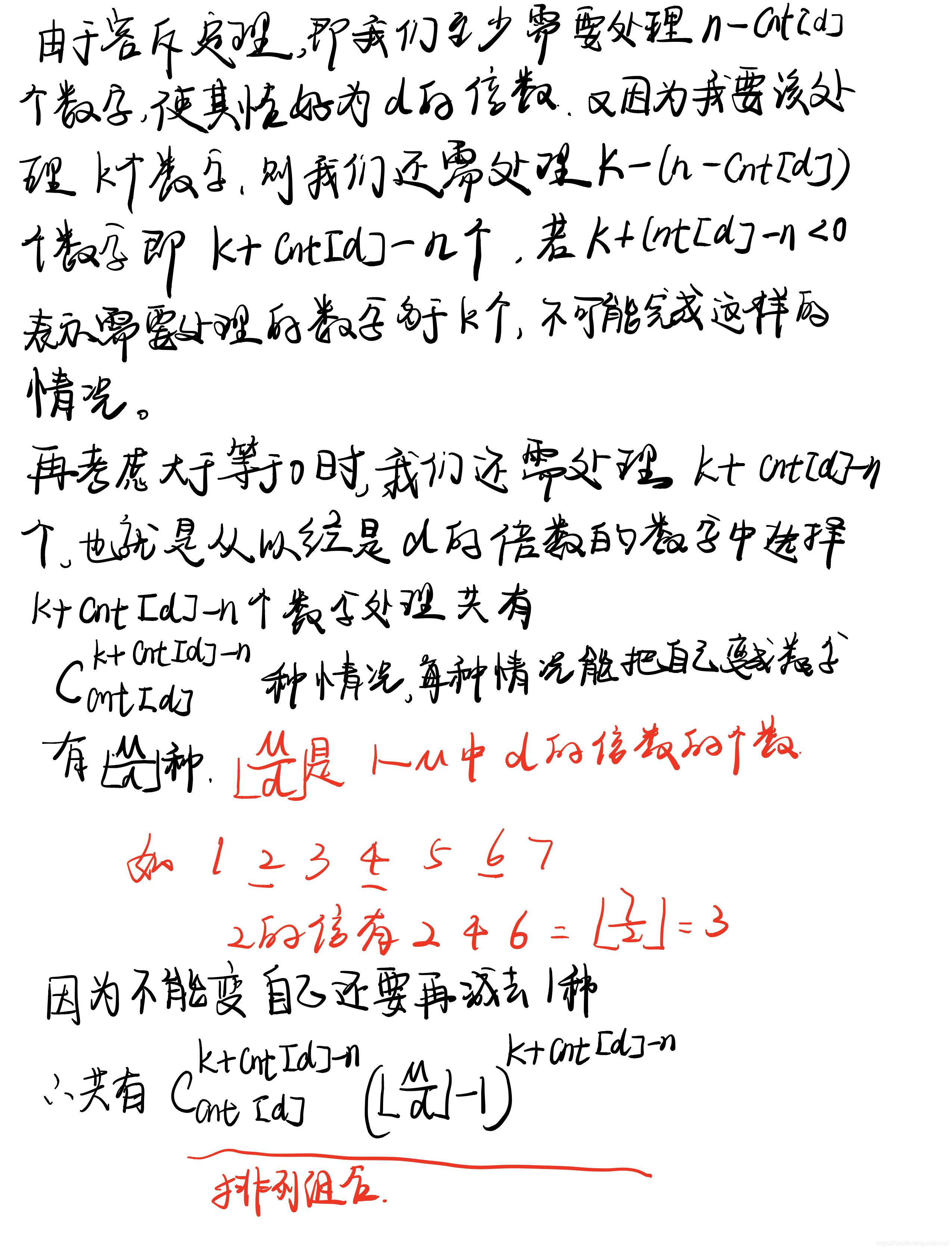先放知识点:
莫比乌斯反演
卢卡斯定理求组合数
乘法逆元
快速幂取模
GCD of Sequence
Alice is playing a game with Bob.
Alice shows N integers a 1, a 2, …, a N, and M, K. She says each integers 1 ≤ a i ≤ M.
And now Alice wants to ask for each d = 1 to M, how many different sequences b 1, b 2, …, b N. which satisfies :
1. For each i = 1…N, 1 ≤ b[i] ≤ M
2. gcd(b 1, b 2, …, b N) = d
3. There will be exactly K position i that ai != bi (1 ≤ i ≤ n)
Alice thinks that the answer will be too large. In order not to annoy Bob, she only wants to know the answer modulo 1000000007.Bob can not solve the problem. Now he asks you for HELP!
Notes: gcd(x 1, x 2, …, x n) is the greatest common divisor of x 1, x 2, …, x n
Input
The input contains several test cases, terminated by EOF.
The first line of each test contains three integers N, M, K. (1 ≤ N, M ≤ 300000, 1 ≤ K ≤ N)
The second line contains N integers: a 1, a 2, …, a n (1 ≤ a i ≤ M) which is original sequence.
Output
For each test contains 1 lines :
The line contains M integer, the i-th integer is the answer shows above when d is the i-th number.
Sample Input
3 3 3
3 3 3
3 5 3
1 2 3
1
2
3
4
Sample Output
7 1 0
59 3 0 1 1
1
2
Hint
In the first test case :
when d = 1, {b} can be :
(1, 1, 1)
(1, 1, 2)
(1, 2, 1)
(1, 2, 2)
(2, 1, 1)
(2, 1, 2)
(2, 2, 1)
when d = 2, {b} can be :
(2, 2, 2)
And because {b} must have exactly K number(s) different from {a}, so {b} can't be (3, 3, 3), so Answer = 0



卢卡斯求组合数是log级别的所以没问题
#include <bits/stdc++.h>
using namespace std;
const int maxn = 310000;
const int mod = 1000000007;
int n, m, k;
int prime[maxn], tot, mu[maxn]; //莫比乌斯函数
bool vis[maxn];
long long fac[maxn], rev[maxn]; //乘法逆元,和卢卡斯定理
long long F[maxn], f[maxn]; //莫比乌斯反演
int a[maxn];
int cnt[maxn]; //对于d,有多少a[i]是d的倍数
long long extend_gcd(long long a, long long b, long long &x, long long &y)
{
//扩展欧几里得
if (a == 0 && b == 0)
return -1;
if (b == 0)
{
x = 1;
y = 0;
return a;
}
long long d = extend_gcd(b, a % b, y, x);
y -= a / b * x;
return d;
}
long long mod_rev(long long a, long long n) //乘法逆元lucas用
{
long long x, y;
long long d = extend_gcd(a, n, x, y);
if (d == 1)
return (x % n + n) % n;
else
return -1;
}
void init() //线性筛求莫比乌斯函数
{
tot = 0;
mu[1] = 1;
for (int i = 2; i < maxn; i++)
{
if (!vis[i])
{
prime[tot++] = i;
mu[i] = -1;
}
for (int j = 0; j < tot; j++)
{
if (i * prime[j] >= maxn)
break;
vis[i * prime[j]] = 1;
if (i % prime[j] == 0)
{
mu[i * prime[j]] = 0;
break;
}
else
{
mu[i * prime[j]] = -mu[i];
}
}
}
fac[0] = rev[0] = 1;
for (int i = 1; i < maxn; i++)
{
fac[i] = fac[i - 1] * i % mod;
//预处理卢卡斯定理参数
rev[i] = mod_rev(fac[i], mod);
//预处理逆元
}
}
long long quick_mod(long long a, long long b)
{
long long ans = 1;
a %= mod;
while (b)
{
if (b & 1)
{
ans = ans * a % mod;
b--;
}
b >>= 1;
a = a * a % mod;
}
return ans;
}
long long Lucas(long long m, long long n)
{
if (n == 0)
return 1;
long long ans = fac[m] * rev[n] % mod * rev[m - n] % mod;
return ans;
}
int main()
{
init();
while (scanf("%d%d%d", &n, &m, &k) != EOF)
{
memset(cnt, 0, sizeof cnt);
memset(f, 0, sizeof f);
for (int i = 1; i <= n; i++)
{
scanf("%d", &a[i]);
cnt[a[i]]++;
}
for (int i = 1; i <= m; i++)
for (int j = i + i; j <= m; j += i)
cnt[i] += cnt[j];
for (int i = 1; i <= m; i++)
{
long long p = cnt[i];
if (k - n + p < 0)
{
F[i] = 0;
continue;
}
F[i] = Lucas(p, k - n + p) * quick_mod(m / i - 1, k - n + p) % mod * quick_mod(m / i, n - p) % mod;
}
for (int i = 1; i <= m; i++)
{
if (F[i] == 0)
f[i] = 0;
else
for (int j = i; j <= m; j += i)
{
f[i] += mu[j / i] * F[j];
f[i] %= mod;
}
printf("%lld", (f[i] + mod) % mod);
if (i != m)
printf(" ");
}
printf("
");
}
return 0;
}